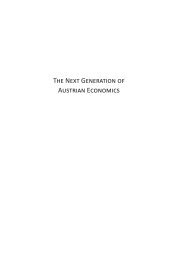capitalist_and_entrepreneur_klein
capitalist_and_entrepreneur_klein
capitalist_and_entrepreneur_klein
You also want an ePaper? Increase the reach of your titles
YUMPU automatically turns print PDFs into web optimized ePapers that Google loves.
7<br />
ownership of the means of production, there would be no market prices<br />
for capital goods, <strong>and</strong> therefore no way for decision-makers to evaluate<br />
the relative efficiency of various production techniques. Anticipating the<br />
later argument for “market socialism,” Mises argued that even if there<br />
were markets for consumer goods, a central planner could not “impute”<br />
meaningful prices to capital goods used to produce them. In short, without<br />
market-generated prices for both capital <strong>and</strong> consumer goods, even the<br />
most dedicated planner would find it “impossible” to allocate resources<br />
according to consumer wants.<br />
roughout the 1920s <strong>and</strong> early 1930s Mises’s argument became the<br />
focus of intense discussion within the German-language literature. Eventually<br />
it was agreed that Mises was correct at least to point out that a<br />
socialist society could not do without such things as money <strong>and</strong> prices,<br />
as some early socialists had suggested, <strong>and</strong> that there was no feasible way<br />
to set prices according, say, to quantities of labor time. Nonetheless, it<br />
was felt that Vilfredo Pareto <strong>and</strong> his follower Enrico Barone (1908) had<br />
shown that nothing was “theoretically” wrong with socialism, because the<br />
requisite number of dem<strong>and</strong> <strong>and</strong> supply equations to make the system<br />
“determinate” would exist under either capitalism or socialism. If the<br />
planners could somehow get the necessary information on preferences <strong>and</strong><br />
technology, they could in principle compute an equilibrium allocation of<br />
final goods.<br />
e most important response to Mises, however, <strong>and</strong> the one almost<br />
universally accepted by economists, was what became known as “market<br />
socialism” or the “mathematical solution,” developed by Fred Taylor<br />
(1929), H. D. Dickinson (1933), Abba Lerner (1934), <strong>and</strong> Oskar Lange<br />
(1936–37). In a system of market socialism, capital goods are collective<br />
property, but individuals are free to own <strong>and</strong> exchange final goods <strong>and</strong><br />
services. e system would work like this. First, the Central Planning<br />
Board chooses arbitrary prices for consumer <strong>and</strong> capital goods. At those<br />
prices, the managers of the various state-owned enterprises are instructed<br />
to produce up to the point where the marginal cost of each final good is<br />
equal to its price, <strong>and</strong> then to choose the input mix that minimizes the<br />
average cost of producing that quantity. en, consumer goods prices are<br />
“e Problem of Value in the Socialist Community” (1902) <strong>and</strong> parts of Max Weber’s<br />
Economy <strong>and</strong> Society (1921).








